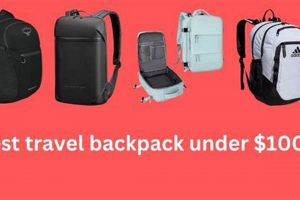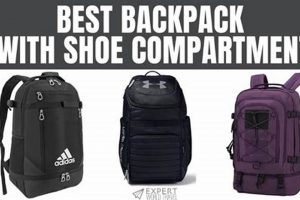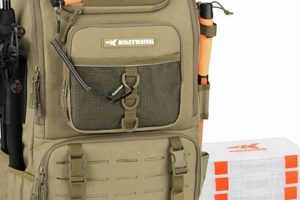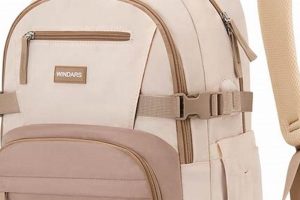Essential equipment for wilderness emergencies or prolonged outdoor expeditions, specialized rucksacks are designed to carry provisions, tools, and protective gear. These packs are engineered for durability, load-bearing capacity, and often incorporate features like water resistance and organizational compartments. A typical example would be a 50-liter pack containing a first-aid kit, water filtration system, emergency shelter, and navigation tools.
Their significance lies in enabling individuals to self-reliantly navigate challenging environments and mitigate potential risks. Historically, the development of these packs evolved from simple carriers to sophisticated systems incorporating ergonomic designs and advanced materials. Their use has expanded from military applications to civilian activities like hiking, camping, and disaster preparedness, contributing to increased safety and independence in remote locations.
Understanding the nuances of load distribution, material construction, and specific feature sets is crucial when selecting a suitable pack. Factors such as intended duration of use, environmental conditions, and individual physical capabilities should inform the decision-making process. The following sections will delve into these critical considerations, providing a detailed overview of the key aspects to evaluate when choosing a pack for demanding situations.
Selection and Utilization Guidance
This section provides crucial guidance for selecting and effectively utilizing a suitable pack. Careful consideration of these points will significantly enhance preparedness in emergency or remote situations.
Tip 1: Assess Load Capacity Requirements: Determine the necessary volume and weight capacity based on the expected duration and nature of the expedition. A longer trip necessitates a larger volume and robust weight-bearing capabilities.
Tip 2: Prioritize Durability and Material Quality: Opt for packs constructed from high-denier nylon or similar robust materials with reinforced stitching. Inspect zippers and buckles for sturdiness; these are common points of failure.
Tip 3: Evaluate Suspension System and Fit: A well-designed suspension system distributes weight effectively, reducing strain on the back and shoulders. Ensure the torso length and hip belt are appropriately sized for the individual.
Tip 4: Incorporate Water Resistance or Waterproofing: Consider a pack with a durable water repellent (DWR) coating or integrated rain cover. For wet environments, a fully waterproof pack or dry bags for internal storage are essential.
Tip 5: Organize Contents Strategically: Utilize compartments and external attachment points to organize gear logically. Heavier items should be positioned close to the back and centered for stability.
Tip 6: Practice Packing and Deployment: Familiarize yourself with the pack’s features and practice packing and unpacking efficiently. This will save valuable time and reduce stress in an emergency.
Tip 7: Regularly Inspect and Maintain the Pack: Check for wear and tear, clean the pack after each use, and repair any damage promptly. Proper maintenance extends the pack’s lifespan and ensures its reliability.
Adhering to these guidelines will lead to a more informed selection process and enhance the overall effectiveness of the pack, improving safety and self-reliance in demanding conditions.
The following sections will offer detailed information to consider when choosing the right pack for specific scenarios.
1. Durability
Durability, in the context of specialized rucksacks, refers to the ability of the pack to withstand wear, tear, and environmental stressors without compromising its structural integrity or functionality. This characteristic is paramount because a failure in the pack’s construction can lead to loss of essential gear, exposure to the elements, and potentially life-threatening situations. For example, a pack constructed from low-quality materials may tear under the weight of supplies during a multi-day trek, rendering the carried provisions inaccessible. The higher the durability, the less likely there are to be failures.
The importance of durability extends beyond mere resistance to physical damage. A durable pack must also withstand prolonged exposure to sunlight, moisture, and temperature fluctuations. The degradation of fabric and stitching under UV radiation can weaken the pack over time, increasing the risk of failure. Similarly, the infiltration of moisture can damage stored items and accelerate the deterioration of the pack itself. A pack designed for environments with potential hazards, from sharp rocks to abrasive terrain, must utilize materials engineered for resistance and high-end performance.
Therefore, durability is a non-negotiable attribute. Selection criteria should prioritize materials with high tensile strength, abrasion resistance, and weather resistance. Reinforced stitching at stress points, robust zippers, and durable buckles are indicators of a well-constructed and rugged pack. Understanding the interplay between material science, construction techniques, and environmental factors is crucial for choosing a pack that will perform reliably under adverse conditions. Durability assures dependability and ensures that a pack can consistently function as intended.
2. Capacity
Capacity, in the context of essential packs, directly correlates to the duration and scope of a person’s ability to persevere in challenging conditions. A pack with insufficient volume restricts the quantity of necessary supplies, such as food, water, medical equipment, and shelter components, thereby limiting operational endurance and increasing vulnerability to environmental hazards. For example, a 30-liter pack may prove inadequate for a multi-day expedition in a cold or arid climate where substantial volumes of water, insulating clothing, and high-calorie sustenance are required.
Conversely, excessive capacity can lead to overpacking, resulting in increased weight and reduced mobility. This, in turn, can elevate the risk of fatigue, injury, and decreased agility, all of which compromise survival prospects. Selecting a pack with appropriate capacity necessitates a careful assessment of anticipated needs, considering factors such as climate, terrain, mission duration, and individual physical capabilities. A well-chosen pack efficiently balances the volume of supplies with the user’s ability to comfortably and effectively carry the load. Consider scenarios of a 70-liter pack that, while spacious, becomes cumbersome on a dense forest trek, diminishing movement capabilities.
Therefore, capacity should be determined by balancing the necessity to carry sufficient resources with the need for agility and efficiency in challenging environments. The interplay of these factors informs the selection of the optimal pack size, impacting safety and operational success. Understanding this relationship is vital for making informed decisions regarding the selection process, and ensures adequate provision for exigencies while mitigating the risks associated with excessive loads. Further sections will discuss strategies for efficient packing and weight management to optimize the use of a pack’s capacity.
3. Ergonomics
Ergonomics, in the context of load-bearing equipment, fundamentally impacts the efficiency and safety of the user. A well-designed pack distributes weight evenly across the body, minimizing strain on specific muscle groups and joints. Poor ergonomic design can lead to discomfort, fatigue, and, over prolonged use, musculoskeletal injuries. For example, a pack with inadequate lumbar support can cause lower back pain, hindering mobility and compromising the ability to perform essential tasks. The goal of ergonomics in the best packs is to reduce the physical burden and maximize operational effectiveness.
Effective ergonomic design incorporates adjustable shoulder straps, hip belts, and torso lengths to accommodate variations in body size and shape. This customization ensures a snug and secure fit, preventing the pack from shifting during movement and maintaining a stable center of gravity. Advanced features such as ventilated back panels enhance breathability, reducing perspiration and improving comfort in hot or humid conditions. The design has cause-and-effect relations with operational performance, and a poorly fitted pack can impede movement, increase energy expenditure, and limit situational awareness. These are all critical for mission success.
Ultimately, prioritizing ergonomics is essential when selecting a pack for demanding situations. The long-term benefits of a comfortable and well-fitted pack far outweigh any marginal cost savings associated with inferior designs. Understanding the principles of ergonomic design enables informed decision-making, ensuring the equipment supports rather than hinders the user’s ability to navigate challenging environments and accomplish critical tasks. It enables the user to travel further, for longer, and with more resources. The next section covers water resistance.
4. Water Resistance
Water resistance is a critical attribute that influences the performance and reliability of equipment. The ability of a pack to protect its contents from moisture directly impacts survival prospects in adverse conditions.
- Material Integrity
The fabric’s inherent water-resistant properties, often achieved through coatings or laminations, determine the pack’s initial defense against water penetration. For example, high-denier nylon treated with a durable water repellent (DWR) finish can repel light rain and splashes. However, prolonged exposure or submersion requires more robust waterproofing measures.
- Construction Techniques
Seams and closures are vulnerable points for water entry. Taped seams and waterproof zippers significantly enhance a pack’s ability to withstand wet conditions. The absence of these features compromises water resistance, allowing moisture to seep into the pack’s interior.
- Internal Protection
Even with external water resistance, internal dry bags or liners provide an additional layer of security for sensitive items such as electronics, medical supplies, and bedding. These internal barriers ensure the contents remain dry, regardless of external conditions, mitigating the risk of equipment malfunction or spoilage.
- Environmental Considerations
The specific environment dictates the required level of water resistance. Packs intended for use in consistently wet environments necessitate higher levels of waterproofing than those designed for occasional exposure to rain. Understanding the anticipated weather conditions is essential for selecting a pack with appropriate water resistance capabilities.
The interplay of these facets dictates the overall effectiveness of a pack’s water resistance. While material and construction contribute to initial protection, internal measures provide redundancy. Matching the water resistance capabilities to the expected environmental conditions is paramount for safeguarding essential supplies and maintaining operational readiness.
5. Organization
Effective organization is a critical determinant of a survival pack’s utility, influencing accessibility, efficiency, and overall preparedness. A well-organized pack enables rapid retrieval of essential items, minimizes wasted space, and facilitates efficient inventory management during emergency situations.
- Dedicated Compartments for Critical Gear
Separate compartments for first aid supplies, navigation tools, water purification devices, and communication equipment are essential. This compartmentalization allows immediate access to these items without rummaging through the entire pack. In emergency situations, time is of the essence; readily accessible medical supplies, for instance, can be the difference between a manageable situation and a critical incident.
- Modular Pouches and Attachment Systems
The integration of modular pouches and attachment systems, such as MOLLE (Modular Lightweight Load-carrying Equipment), allows for customization and adaptability. Users can configure the pack to suit specific mission requirements, adding or removing pouches based on the anticipated needs. This flexibility ensures that only essential items are carried, reducing unnecessary weight and bulk.
- Color-Coding and Labeling
Implementing a color-coding system and labeling compartments can further enhance organization and accessibility. Assigning specific colors to different categories of supplies (e.g., red for medical, blue for water) allows for rapid identification, even in low-light conditions or stressful situations. Labels provide clear and concise information about the contents of each compartment, eliminating guesswork and minimizing wasted time.
- Strategic Weight Distribution
Organization also encompasses strategic weight distribution within the pack. Heavier items should be positioned close to the back and centered to maintain balance and stability. Lighter items can be placed further away from the body. Proper weight distribution reduces strain and fatigue, improving overall mobility and endurance during prolonged use.
The efficiency of each component of a pack are related and impacts the overall performance. Therefore, organization is not merely about arranging items; it is about optimizing accessibility, efficiency, and weight distribution to enhance survivability and mission effectiveness. Effective organization transforms a simple container into a highly functional system that significantly improves preparedness in demanding situations.
6. Accessibility
Accessibility, in the context of specialized rucksacks, is not merely about ease of reach, but rather the strategic design and configuration that enables immediate and unhindered access to essential supplies, particularly under duress or in low-visibility conditions. The integration of thoughtful access solutions directly correlates with the speed and efficiency with which individuals can respond to critical situations.
- External Attachment Points for Rapid Deployment Gear
The inclusion of external loops, straps, and attachment points facilitates the quick deployment of frequently used items such as knives, headlamps, and water bottles, without requiring the user to open the main compartment. For example, a readily accessible knife can be critical for cutting rope or preparing tinder in an emergency. This external access minimizes time wasted searching for essential tools.
- Multiple Access Points to Main Compartment
Beyond a single top-loading entry, packs incorporating side zippers, panel loaders, or clamshell designs offer multiple access points to the main compartment. This design allows for targeted retrieval of items located deep within the pack without unpacking the entire contents. The ability to quickly access a sleeping bag or first-aid kit, irrespective of its position within the pack, significantly enhances response time in critical situations.
- Intuitive Compartment Layout and Markings
The internal organization of compartments, combined with clear markings or color-coding, contributes to intuitive accessibility. Dedicated pockets for specific items, such as maps, communication devices, and food rations, streamline the retrieval process. Standardized markings or color schemes allow the user to quickly locate and identify the necessary item, even in low-light or high-stress scenarios.
- Glove-Friendly Zippers and Buckles
The design of zippers and buckles to accommodate gloved hands ensures that essential supplies remain accessible in cold weather conditions. Small or difficult-to-manipulate closures can impede access, potentially delaying critical actions. Large, durable zippers and buckles that can be operated with gloved hands maintain accessibility regardless of environmental conditions.
These facets of accessibility, when thoughtfully integrated into the design, transform a carrying device into a responsive system that supports immediate action and enhances survivability. Accessibility ensures that equipment functions not merely as a repository, but as an active tool that empowers individuals to respond effectively to evolving threats and challenges.
7. Weight
Weight, in the context of survival equipment, represents a critical limiting factor influencing endurance, agility, and overall mission effectiveness. A pack’s mass directly affects the energy expenditure required for movement, particularly across challenging terrain. Excessive weight leads to accelerated fatigue, increased risk of injury, and diminished capacity for performing essential tasks. A 72-hour pack that weighs over 40 pounds, for example, could drastically reduce a person’s mobility, impacting the ability to travel long distances to secure resources or evade threats. Weight must be critically assessed to guarantee usability for an extended period of time.
The interplay between pack weight and the individual’s physical conditioning must be considered. While a seasoned wilderness expert might tolerate a heavier load, a less experienced individual could quickly become incapacitated. The pack’s design should facilitate efficient weight distribution, positioning heavier items closer to the center of gravity to maintain balance and minimize strain on the musculoskeletal system. This requires that internal components are also selected for weight. Water filtration equipment, tents, medical equipment all contain weight and mass that must be assessed.
Optimization of pack weight involves careful selection of lightweight, high-performance materials and equipment. This includes considerations such as choosing titanium cookware over stainless steel, utilizing dehydrated food rations, and opting for a minimalist shelter system. Prioritizing essential items and eliminating unnecessary gear further reduces the overall load. Maintaining a balance between essential supplies and manageable weight is crucial for ensuring long-term survivability and operational capability. Therefore, the weight is more than just a consideration, but it is the first point of concern.
Frequently Asked Questions
The following addresses commonly encountered queries regarding the selection and utilization of packs. The answers provided aim to offer clarity and guidance to those seeking reliable and effective equipment.
Question 1: What is the optimal pack volume for a three-day wilderness excursion?
The appropriate pack volume is contingent on factors such as climate, terrain, and individual needs. Generally, a volume between 50 and 75 liters is adequate for a three-day trip, allowing for the carriage of essential supplies, including shelter, food, water, and protective clothing. Adjustments should be made based on specific environmental conditions and personal preferences.
Question 2: How can pack weight be minimized without compromising essential gear?
Weight reduction can be achieved through the careful selection of lightweight, high-performance materials, such as titanium cookware and dehydrated food rations. Prioritization of essential items and elimination of non-essential gear are also critical. A systematic evaluation of each item’s necessity contributes to significant weight savings.
Question 3: What materials offer the best balance of durability and weight?
High-denier nylon fabrics, particularly those with ripstop weaves, provide a robust combination of durability and lightweight properties. These materials withstand abrasion and resist tearing while maintaining a manageable weight. Reinforcements at stress points further enhance the pack’s overall resilience.
Question 4: How important is water resistance in a pack, and what features contribute to it?
Water resistance is crucial for protecting supplies from moisture damage. Durable water repellent (DWR) coatings, taped seams, and waterproof zippers enhance a pack’s ability to withstand wet conditions. For prolonged exposure to rain, internal dry bags offer an additional layer of protection for sensitive items.
Question 5: What are the key ergonomic considerations when selecting a pack?
Ergonomic design should include adjustable shoulder straps, hip belts, and torso lengths to accommodate variations in body size and shape. A well-designed suspension system distributes weight evenly, minimizing strain on the back and shoulders. Proper fit is essential for comfort and injury prevention.
Question 6: How should a pack be organized to ensure efficient access to essential items?
Organization can be improved through the use of dedicated compartments, modular pouches, and color-coding systems. Critical items, such as first aid supplies and navigation tools, should be readily accessible. Strategic weight distribution, with heavier items positioned close to the back, maintains balance and stability.
The information presented above aims to address common inquiries, facilitating a more informed decision-making process. Thoughtful consideration of these factors enhances the selection of a suitable pack, improving safety and self-reliance in challenging conditions.
The next section will offer detailed information to consider when choosing a specific pack for specific scenarios.
Best Survival Backpacks
This exploration has provided a comprehensive overview of critical factors pertaining to optimized load-bearing equipment. The key features, including durability, capacity, ergonomics, water resistance, organization, accessibility, and weight, have been thoroughly examined to illustrate their individual and collective impacts on functionality and survivability. This information equips individuals with the knowledge necessary to make informed decisions based on specific mission parameters and environmental challenges.
Ultimately, the selection process should reflect a commitment to preparedness and a dedication to mitigating potential risks. Emphasizing thorough research and careful consideration ensures that the equipment enhances the probability of successful navigation of difficult circumstances. Selecting appropriate, high-quality load-bearing equipment represents a commitment to self-reliance and resilience, both of which are paramount in challenging environments.


![Top-Rated: Best Treestand Backpack [Buyer's Guide] Ultimate Backpack Traveler Guide: Tips, Destinations & Budget Hacks Top-Rated: Best Treestand Backpack [Buyer's Guide] | Ultimate Backpack Traveler Guide: Tips, Destinations & Budget Hacks](https://backpack-traveler.com/wp-content/uploads/2025/11/th-872-300x200.jpg)


![Top Rated: Best Disneyland Backpack [2024 Guide] Ultimate Backpack Traveler Guide: Tips, Destinations & Budget Hacks Top Rated: Best Disneyland Backpack [2024 Guide] | Ultimate Backpack Traveler Guide: Tips, Destinations & Budget Hacks](https://backpack-traveler.com/wp-content/uploads/2025/11/th-801-300x200.jpg)

